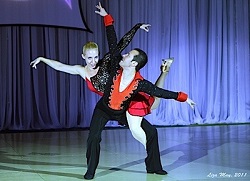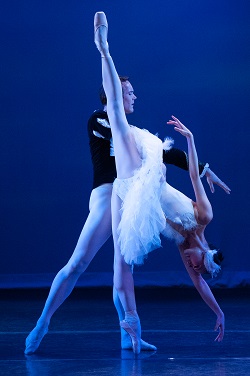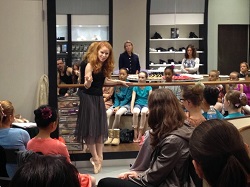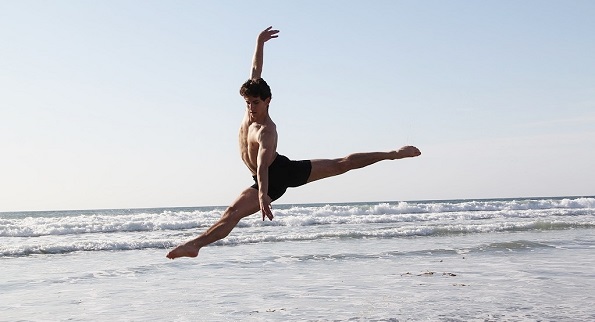How Four Dancers Did It and You Can, Too
By Laura Di Orio of Dance Informa.
New York City: a dance hub of the world. Dancers come from all over the globe to be here, train here, perform here. They’re willing to struggle, sometimes barely make ends meet, try, push, work harder than hard and do whatever it takes to survive here. Every NYC dancer has a different story of their pathway to this city and the drive and determination it took to not only get here but also stay here. Here is a look at some of those stories and advice on how you, too, can make the move.
Mary Carpenter, a dancer, teacher and pointe shoe expert, who is originally from Cincinnati, Ohio, says she moved to NYC in 1990 because she was attracted to the amount of work, variety of art forms and all of the auditions located here. “I love everything the city gives me artistically,” she says. “I go to performances every week, and I love fashion, too, and there are always these amazing sample sales in the Garment District.”
Nolan Seda, who moved to NYC from Puerto Rico in 2009 and is a freelance dancer, choreographer and model, says he made the leap to NYC with the desire to develop his talents to their fullest potential.

West Coast Swing and Hustle dancer Anna Brady Novoa in performance with her husband, who she met at a dance event after moving to NYC. Photo by Liza May.
Anna Brady Novoa, a West Coast Swing and Hustle dancer, moved to NYC in 2005 after living and training in Chicago for a few years. “I moved because of the extensive training and performing opportunities available in a wide range of styles, most within 10 to 15 minutes of each other,” she says.
And some dancers move from across the globe just to be in NYC. Mami Hariyama, a dancer, ballet teacher and dance class accompanist, moved to NYC in 2003 for a fresh start.
Once the reason for moving to NYC for all four of these dancers was established – the city would provide them with an infinite number of opportunities – they had to do whatever was necessary to bring this vision to fruition.
For Carpenter, whose supportive parents let her leave all her extra belongings behind in Ohio, the transition was smooth. She had two siblings who already lived in NYC, and they provided Carpenter with a couch or extra room. She had also visited them in NYC several times before, so she knew how to get around fairly well.
For Seda, the decision was rather impulsive. He was performing Flames of Paris at the time in Hartford, Connecticut, when his backstage manager said one evening, “I’m leaving for New York City tonight. If you want to come with me, let me know.”
“I didn’t even think twice,” Seda recalls. “I called a friend and asked if he would house me for awhile. I grabbed my bags and left. I remember riding in the car, thinking, ‘What am I doing?’”
Novoa made the move with a friend, which eased the transition and logistics. They drove from Chicago to NYC, without even knowing where they’d live once they arrived. “Halfway across Pennsylvania, we got a call from a friend of a friend who had heard of an apartment that was available,” she says. “We accepted it by phone and signed the lease the next day after a quick walk-through.”

Mami Hariyama, of Japan, here with partner Richard Bowman, now lives, dances and runs her own studio in NYC. Photo by Rachel Neville.
Hariyama, who hardly spoke any English at the time of her move, faced extra challenges. “I knew that first I had to learn to speak English to communicate with people,” she says. “I enrolled in language school to study English and also get a visa to stay. We need a visa if we want to live here more than three months.”
For many dancers new to NYC, finding a place to live and a job to pay that often-inflated NYC rent becomes top priority, and it may take some time to settle in and feel completely comfortable, financially, socially and emotionally. But most dancers who take the plunge and move to NYC have motivation and determination, qualities that can make this time easier and worthwhile.
“Finding a place to live is key because space is premium,” Carpenter says. “Have a game plan when you come up here.”
Luckily, there are many ways to apartment hunt even before arriving in the city. Websites and services like Craigslist and Facebook’s Gypsy Housing are free to browse, and sometimes shelling out extra bucks for a broker is worth it and can save stress. Some of the less expensive places to live in NYC are in the outer boroughs, so dancers shouldn’t dismiss the idea of living there. It’s still just a subway ride away from Manhattan.
Finding a way to make money is crucial, too, and dancers may have to accept that they may not score that dream Broadway job within the first week.
“I started right away working full-time at a chocolate shop in Chelsea, while taking ballet classes in the afternoon,” Seda says. “I would come home to check for auditions for guest dancers and then check how to get to the audition. I had to consult the city street map, the subway map and the bus map every day. My day would start at 6 a.m. and finish at midnight. I had no money in my pocket, just enough for my rent, subway, coffee and a quick lunch. Those were very stressful times.”
Likewise, Novoa says she took a part-time position as a chemistry researcher and supplemented her income with tutoring to make ends meet. “It took about four to five months to really settle in and get financially stable,” she says. “Of course, I didn’t have a ton of money, but I could cover my bills and groceries.”
Carpenter, who had clerical skills under her belt, worked in offices when she first arrived. She also got a scholarship at the David Howard Dance Center (DHDC), where she was able to take class next to dancers from every major ballet company.
“What is ‘financially secure’?” Carpenter asks. “If you choose the arts, you are not choosing it to make money. Certain things fell into place after I had been here for about three months. I got my first dance job and also got a job working at a dance store, so those things combined with the scholarship at DHDC made the dream possible.”

Mary Carpenter gives a pointe shoe presentation for ABT/JKO first-time pointe shoe students at Chacott by Freed of London in NYC. Photo courtesy of Carpenter.
Hariyama faced other challenges when she tried to find work. “Every dance school I took my resume to gave me the same answer: I need a working visa,” she recalls. “And if I hired a lawyer to get a visa, it would cost $4,000 or more. I couldn’t afford that, so I studied very hard on how to apply for a visa myself. I had to translate so many documents into English, using a dictionary for every single word, so it took a lot of time.”
Once Hariyama was approved for an artist visa, she had the authority and confidence to get a job. So, she went back to each dance studio, new resume in hand, and soon enough became busy playing piano at Steps on Broadway, Broadway Dance Center, Alvin Ailey and American Ballet Theatre.
Aside from feeling comfortable in a financially stable situation, dancers new to NYC also need a support system, friends. Many dancers agree that making friends can be relatively easy. Open dance classes are big and probably full of unfamiliar faces, but they are also a great way to meet people. There is already common ground, after all!
“I tried to take as many classes as I could and meet as many dancers and instructors as I could,” says Novoa, who even met her now-husband when she went to a West Coast Swing dance one night on a whim with a friend.
NYC is a place full of people, many friendly and helpful, but it can also be a competitive place. Dancers should take advantage of every workshop, audition and opportunity in order to build their resume and career.
“If you look for artistic opportunities, you will find them,” Carpenter advises. “You just have to keep at it and put yourself out there. Do not be afraid to try new things, and always do your professional best, even if the people who hired you are not.”
“My calendar was always on fire, and my legs, too,” Seda says. “You do a lot of walking in the city when you are poor! I mostly got jobs outside of New York that kept me constantly either flying out to other states or catching a train. I started to see progress in my finances two years after. Living expenses, transportation – your life becomes business. Now I can say I have a place to breathe fresh air, but it never ends. This is New York!”
Hariyama, too, says she would take on every job or opportunity that came her way. “Look for opportunity,” she advises. “Look for chances. If somebody gives you an opportunity of work, do it, try it, don’t say no.”
Novoa points out that it’s important to put oneself out there as much as possible but to do so in a nice, respectful way. “Life is very fast-paced and competitive,” she says. “There is always someone there ready to step in and take your place if you hesitate at all. You must be assertive and confident, but no one wants to work with a jerk, and the circles are small. You don’t always know who you’re taking class with, standing next to in line for coffee or riding the elevator with. I’ve seen talented dancers mess up opportunities through rude behavior outside the studios and less talented dancers impress someone they didn’t recognize with their good attitude.”
These four dancers have proved that a dream, hard work and a good attitude can create success in a place like NYC. During their years in the city, they have scooped up every opportunity and created a life of dance that they love.
Carpenter is now a faculty member of Barnard College and The New School University. She also teaches for Steps on Broadway in the young students’ and adult open programs, and she is a professional pointe shoe fitter for Chacott by Freed of London. Seda has since guested for multiple companies, including New York Theatre Ballet and New England Dance Theater, and he was one of David Howard’s last protégés. In addition, he choreographs, teaches dance, models and is working his way up on the big screen. Novoa currently teaches, competes and performs West Coast Swing and Hustle partner dance styles with her husband, Erik. Hariyama still plays the piano and performs, but she is now also the director of her own ballet school in NYC, Hariyama Ballet Studio.
These dancers can indeed lend advice to dancers outside of NYC who are thinking of making the move.
“A person has to plan carefully, have clear goals, have made significant professional connections and has to research,” Seda says. “With these things, the move becomes much more possible.”
“You will ride the subway with all of humanity, good, bad, indifferent,” Carpenter adds. “The city can be elating and exhausting at the same time. You have to have a strong sense of self here and good street skills. I always say to young dancers that NYC is not a good place if you don’t have connections, financial means and a really good reason to be here.”
And once in NYC, Novoa advises, “Take master classes, meet choreographers, put together a website and go to your friends’ shows. And do things that scare you. Try new styles, new classes and new auditions. Count your pennies, and schedule one day off a week for rest and recovery. Be prepared that your first, second or third job may require you to travel outside NYC, anywhere from a few days a week to a few weeks a year, while you build up your resume. Take those opportunities. They may not come again, and each leads to something new.”
Photo (top): Dancer Nolan Seda, originally from Puerto Rico, moved to NYC to further opportunities. Photo by Chelsey Penyak.















